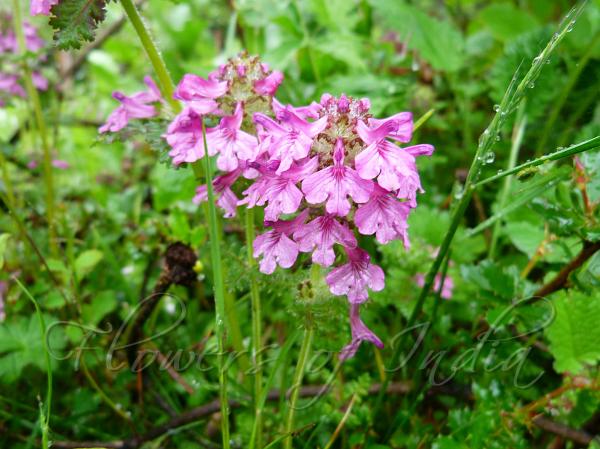|
| Palette Lousewort |
|

|

| File size | 459497 |
| Original date | 6/25/11 7:09 AM |
| Resolution | 2048 x 1536 |
| Flash | Flash did not fire, auto |
| Focal length | 4.5mm |
| Exposure time | 1/60s |
| Aperture | 2.8 |
| Focus Distance | |
| Metering Mode | Multi-segment |
| Camera make | Panasonic |
| Camera model | DMC-FZ40 |
| Sensor type | OneChipColorArea |
|
|
|
|
Photo: |
Botanical name: Pedicularis roylei Family: Orobanchaceae (Broomrape family)
Palette Lousewort is a perennial herb, 7-15 cm
tall, drying black, velvety throughout. The common name lousewort,
applied to Pedicularis species, derives from an old belief that
these plants, when ingested, were responsible for lice infestations in
stock. Flowers are purple-red, 1.7-1.9 cm; tube decurved basally,
1-1.1 cm, expanded above. Upper lip is slightly falcate, 5-8 mm,
rounded in front, margin entire. Lower lip is 8-9 mm, hairless.
Flowers are borne in racemes, up to 6 cm, usually interrupted at the
base. Axis is densely hairy. Bracts are leaflike, proximal ones
slightly longer than flowers. Flower-stalk is 2 mm long. Sepal tube is
bell-shaped, 8-9 mm, densely white or deep purple hairy, sepals 5,
unequal, ovate-oblong, about 1/3 as long as sepal tube, toothed or
cut. Roots are fleshy, up to 4-8 mm in diameter. Stems are one to
several, erect or outer ones ascending, with lines of white hairs.
Leaves are in whorls of 3 or 4. Basal leaves are dense-clumpy and
persistent, stalk up to 3-6 cm. Stem leaves are on short stalks,
barely 2-2.5 cm. Leaf blade is lanceshaped-oblong to ovate-oblong,
2.5-4 cm, pinnately cut into 7-12 pairs of segments, lanceshaped to
oblong, incised-toothed. Capsule ovoid-lanceolate, about 1.2 cm, short
tipped. Seeds 1.2-1.5 mm. Palette Lousewort is found in moist alpine
meadows, among small Rhododendron, in the Himalayas, at altitudes of
3400-5500 m. Flowering: July-August.
| Identification credit: Nongthombam Ullysess | Photographed in Yumthang Valley, Sikkim. |
• Is this flower misidentified? If yes,